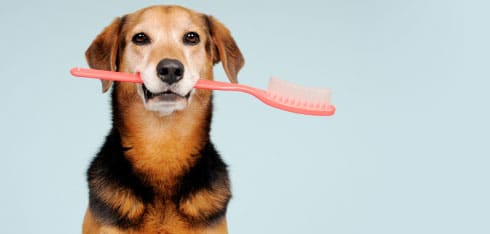Oral Hygiene 101: Back to Basics

Have you ever heard of dental plaque? Dental plaque is the “fuzzy slipper material” adhering to the enamel surfaces of teeth. In essence, it is a collection of bacteria. Did you know that it could form in as little as 24 hours? Have you ever heard of dental tartar? Dental tartar is the “hard mineral-like material” that attaches to the enamel surface of teeth. Dental tartar is comprised of calcium salts from saliva. Did you know that it can take as little as 72 hours for tartar to accumulate? Consequently, we believe that routine oral hygiene is imperative to keep your pet’s oral cavity and teeth healthy!
Just like with humans, good oral hygiene for dogs involves brushing their teeth regularly (at least once a week) using a dog-specific toothpaste and toothbrush. It's also important to clean their gums regularly with a damp cloth.
In addition to brushing their teeth, it's important to provide your dog with chew toys and treats that help clean their teeth and gums. Dental diets are also a great way to help keep your dog's teeth healthy - look for dental diets that specifically mention being beneficial for oral health.
Pet oral health is important for several reasons. First, if your pet has poor dental hygiene, they're at risk for developing gum disease, which can lead to problems with their teeth and gums. Additionally, poor oral health can also lead to bad breath, which is not only unpleasant for you and your pet but can also be a sign of an underlying health problem. Finally, as pets age, their teeth can become discolored or stained from years of built-up tartar and plaque; regular brushing can help prevent this.
There are a few different ways to clean your dog's teeth naturally. One way is to give your dog chew toys or bully sticks to gnaw on. This will help remove plaque and tartar from their teeth. Another way is to give them fresh vegetables or fruits, such as carrots, apples, or celery. These contain natural enzymes that help break down plaque and tartar. You can also brush their teeth with a toothbrush and water, or use an enzymatic toothpaste designed for dogs. Whatever method you choose, be sure to do it regularly to keep your dog's teeth healthy and clean!
Dental plaque can be removed with brushing. Currently, the gold standard for brushing is once a day. However, brushing a couple times a week or even monthly will significantly reduce dental plaque. Remember, routine brushing is better than NO brushing! You may use a pediatric toothbrush or a pet toothbrush with a pet-approved toothpaste (without fluoride) to brush your pet’s teeth. There are dental treats and diets available as well, that can help reduce your pet’s plaque and tartar control. Please visit www.voch.org for a list of approved products towards the optimization of oral hygiene.
Unfortunately, dental tartar cannot be removed with brushing. However, a texture diet or dental treat may be useful in the reduction of dental tartar along with dental plaque. A professional scaling and polishing of the teeth is one of the most effective means of removing dental plaque and tartar.
The VOHC brushing techniques are recommended by AVDC for clinical use, with the following additional comments:
- As standard practice in companion animals, all teeth (and ideally all surfaces of all teeth) should be brushed daily.
- While the standardized VOHC brushing techniques are to be used in dogs and cats in VOHC protocol trials, AVDC and VOHC recognize that some dogs and cats will not cooperate with daily brushing, and may not tolerate the full VOHC brushing sequence.
- Any brushing activity, used regularly, is better than no brushing activity.
- Some periodontal pathology may require use of a different type of brush or different brushing technique, such as when there is a complete furcation defect. AVDC recommends that pet owners ask their veterinarian whether the VOHC standardized brushing technique is appropriate for their dog or cat.
- Dental plaque and tartar accumulate most rapidly on the buccal (cheek) surfaces of the upper teeth of dogs and cats - these areas should be targeted for particular attention during regular brushing that may not include the full VOHC brushing sequence.
- AVDC recognizes that, when practical in clinical use, brushing the teeth of pet dogs and cats should also include additional strokes on the palatal/lingual (“inside”) surfaces of the teeth. The palatal/lingual surfaces are not to be brushed in VOHC trials because doing so would risk inadvertent strokes on the buccal surface of the teeth in this standardized testing model.




